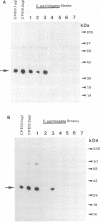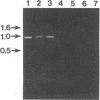Abstract
Clostridium perfringens enterotoxin (CPE) is an important sporulation-associated virulence factor in several illnesses of humans and domestic animals, including C. perfringens type A food poisoning. Therefore, the ability to determine the enterotoxigenicity of food or fecal C. perfringens isolates with simple, rapid assays should be helpful for epidemiologic investigations. In this study, Western immunoblotting (to detect CPE production in vitro) was compared with PCR assays and digoxigenin-labeled probe assays (to detect all or part of the cpe gene) as a method for determining the enterotoxigenicity of C. perfringens isolates. The cpe detection assays yielded reliable results with DNA purified from vegetative C. perfringens cultures, while Western immunoblots required in vitro sporulation of C. perfringens isolates to detect CPE production. Several cpe-positive C. perfringens isolates from diarrheic animals did not sporulate in vitro under commonly used sporulation-inducing conditions and consequently tested CPE negative. This result indicates that cpe gene detection and serologic CPE assays do not necessarily yield similar conclusions about the enterotoxigenicity of a C. perfringens isolate. Until further studies resolve whether these cpe-positive isolates which do not sporulate in vitro can or cannot sporulate and produce CPE in vivo, it may be preferable to use cpe detection assays for evaluating C. perfringens isolate enterotoxigenicity and thereby avoid potential false-negative conclusions which may occur with serologic assays.
Full text
PDF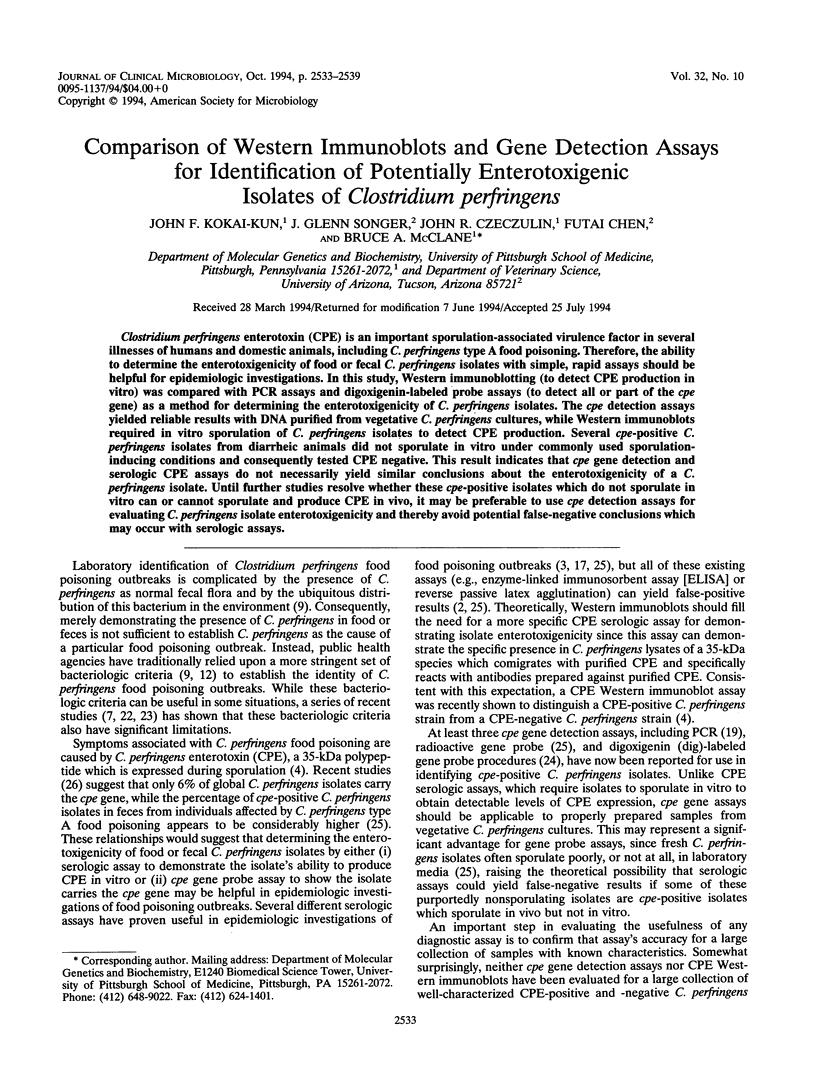
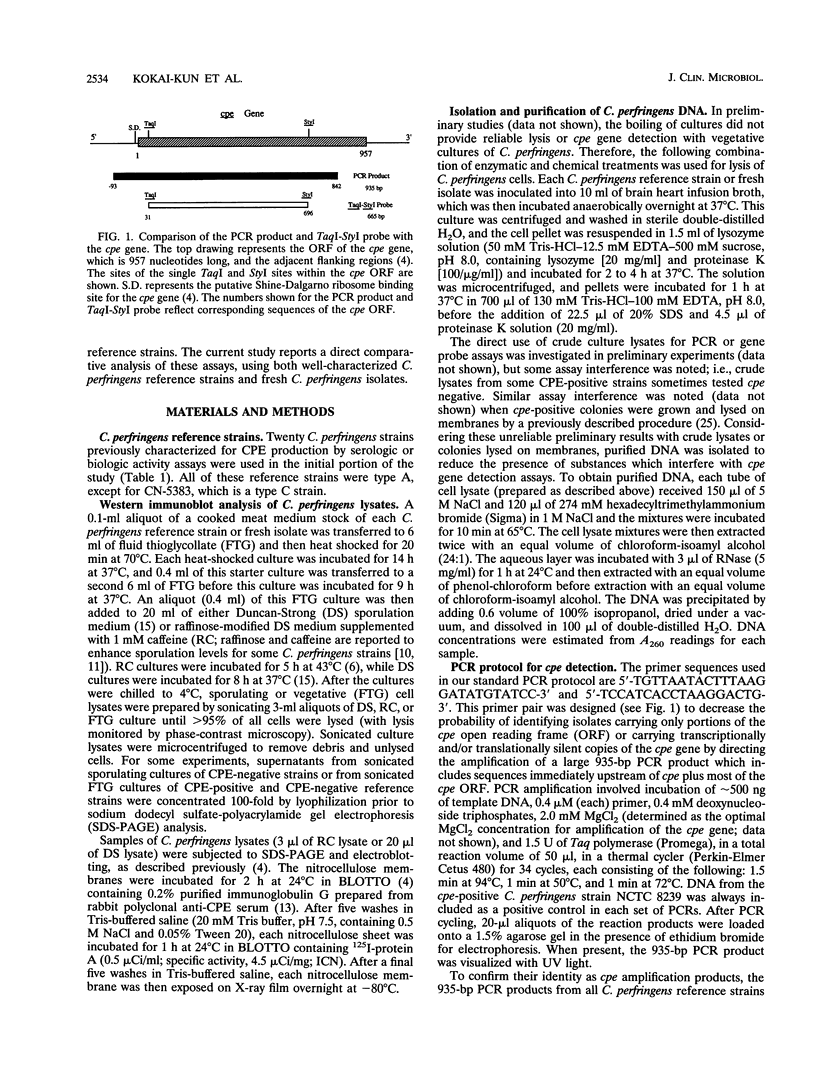
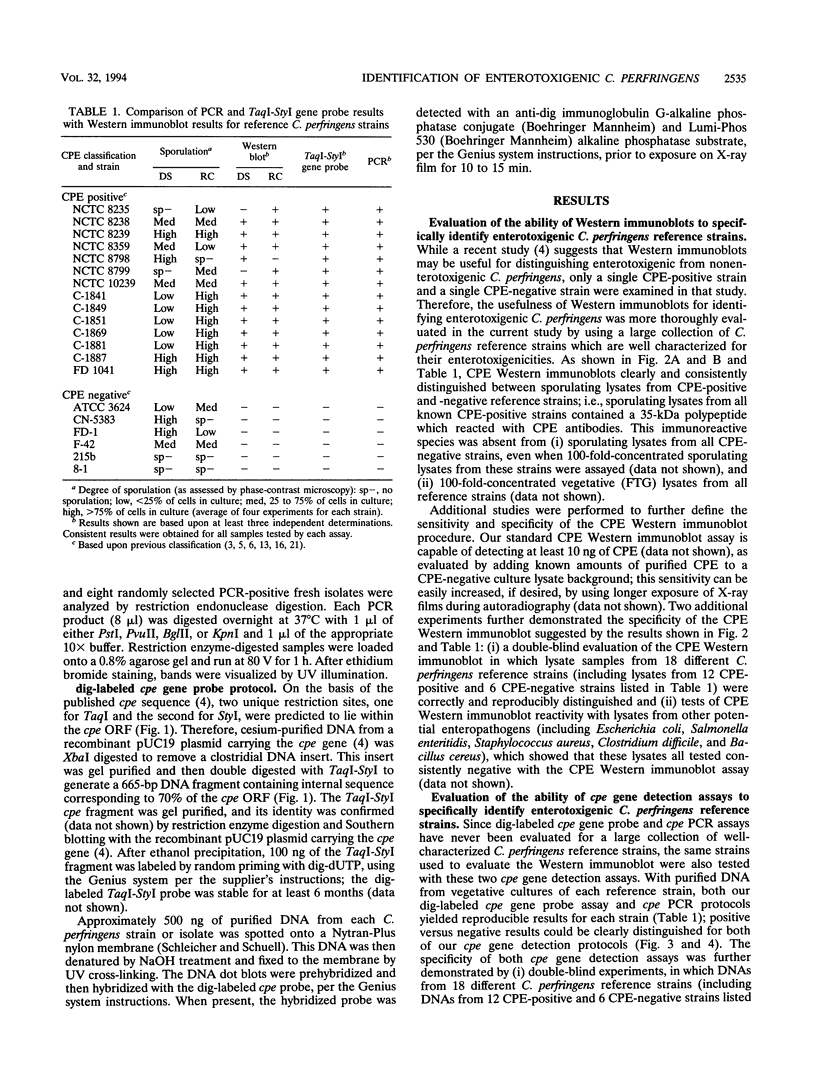
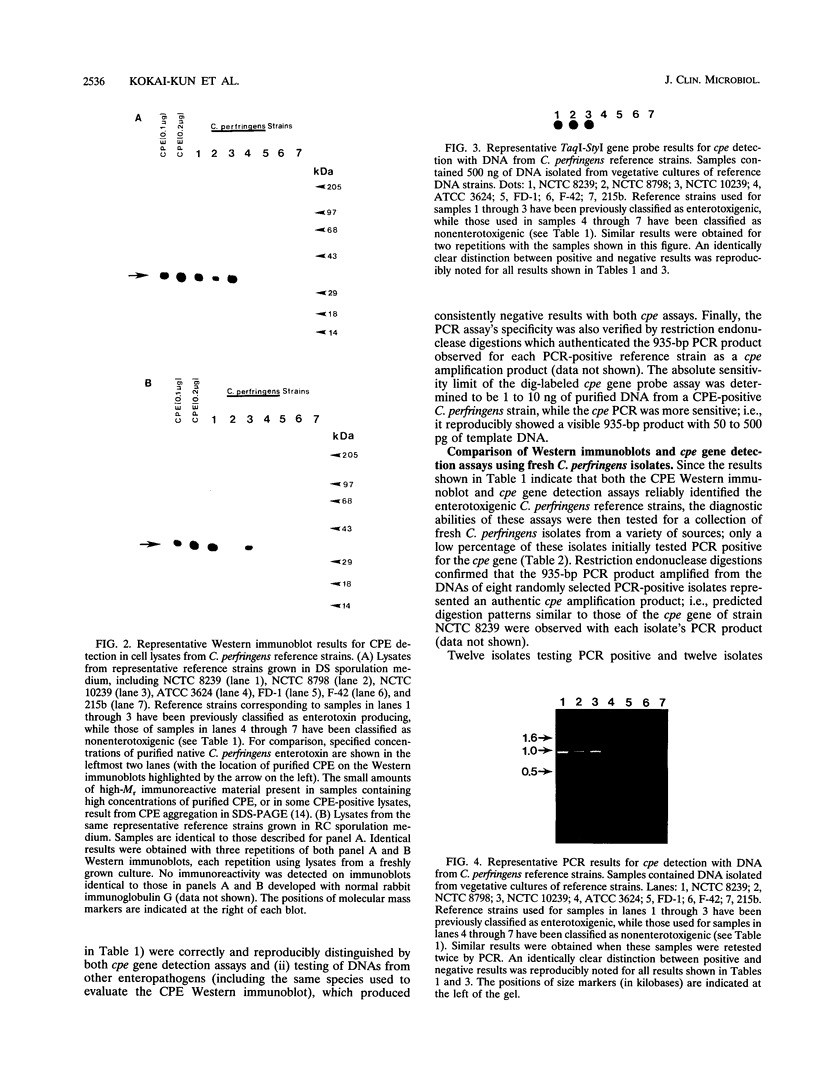
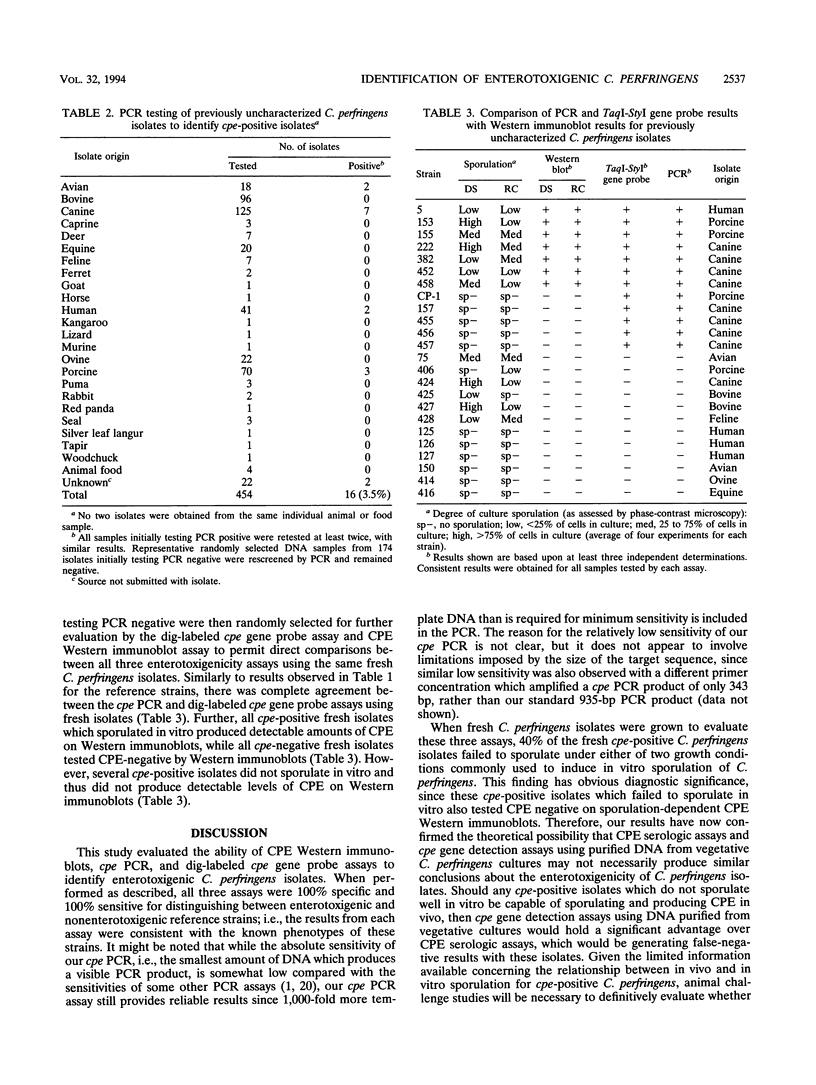
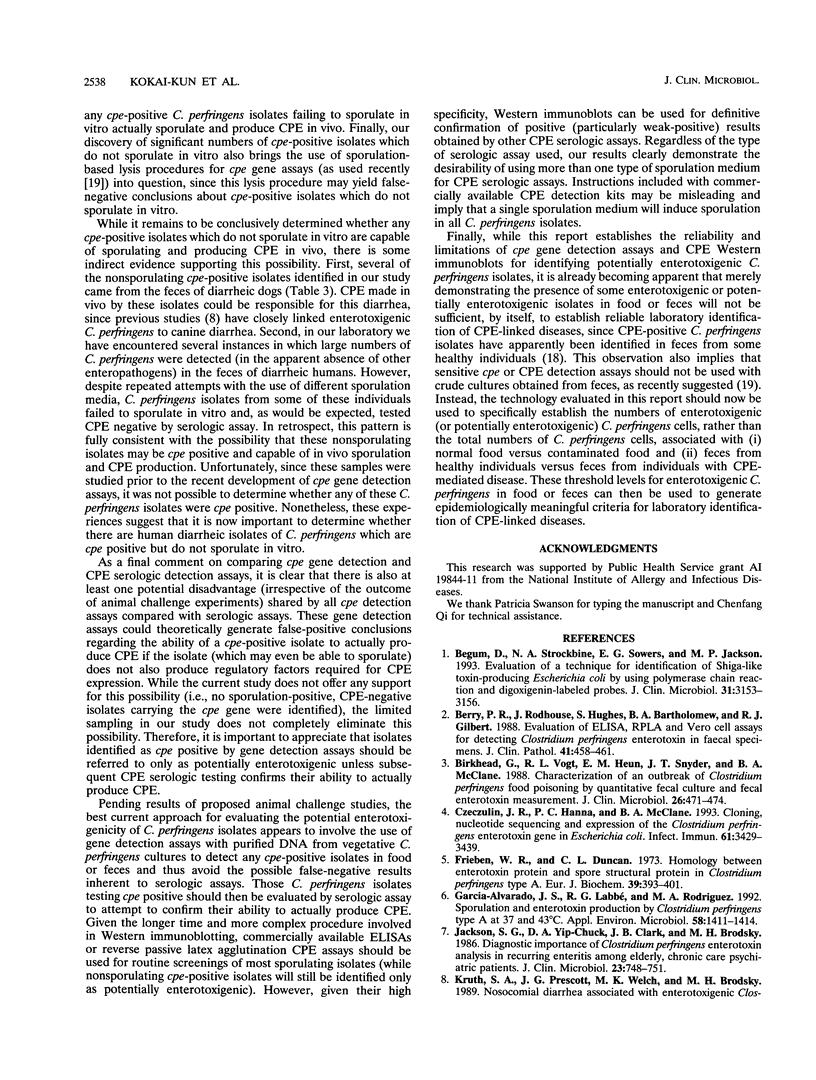
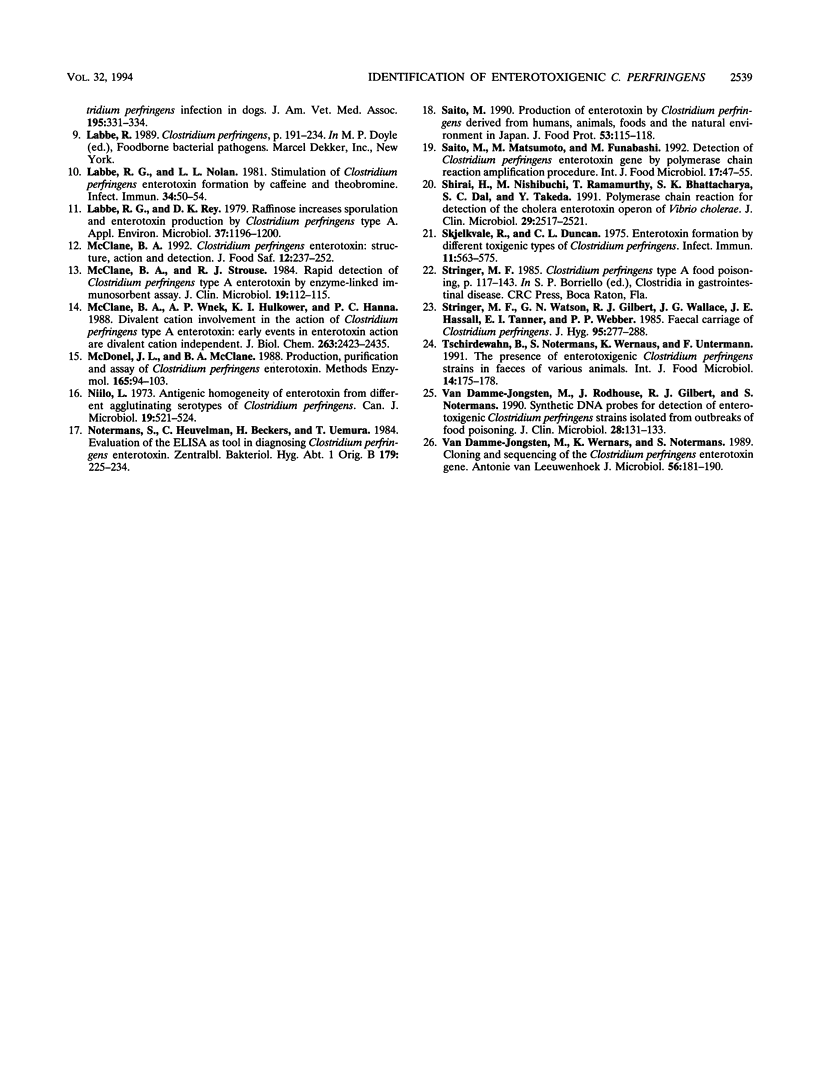
Images in this article
Selected References
These references are in PubMed. This may not be the complete list of references from this article.
- Begum D., Strockbine N. A., Sowers E. G., Jackson M. P. Evaluation of a technique for identification of Shiga-like toxin-producing Escherichia coli by using polymerase chain reaction and digoxigenin-labeled probes. J Clin Microbiol. 1993 Dec;31(12):3153–3156. doi: 10.1128/jcm.31.12.3153-3156.1993. [DOI] [PMC free article] [PubMed] [Google Scholar]
- Berry P. R., Rodhouse J. C., Hughes S., Bartholomew B. A., Gilbert R. J. Evaluation of ELISA, RPLA, and Vero cell assays for detecting Clostridium perfringens enterotoxin in faecal specimens. J Clin Pathol. 1988 Apr;41(4):458–461. doi: 10.1136/jcp.41.4.458. [DOI] [PMC free article] [PubMed] [Google Scholar]
- Birkhead G., Vogt R. L., Heun E. M., Snyder J. T., McClane B. A. Characterization of an outbreak of Clostridium perfringens food poisoning by quantitative fecal culture and fecal enterotoxin measurement. J Clin Microbiol. 1988 Mar;26(3):471–474. doi: 10.1128/jcm.26.3.471-474.1988. [DOI] [PMC free article] [PubMed] [Google Scholar]
- Czeczulin J. R., Hanna P. C., McClane B. A. Cloning, nucleotide sequencing, and expression of the Clostridium perfringens enterotoxin gene in Escherichia coli. Infect Immun. 1993 Aug;61(8):3429–3439. doi: 10.1128/iai.61.8.3429-3439.1993. [DOI] [PMC free article] [PubMed] [Google Scholar]
- Frieben W. R., Duncan C. L. Homology between enterotoxin protein and spore structural protein in Clostridium perfringens type A. Eur J Biochem. 1973 Nov 15;39(2):393–401. doi: 10.1111/j.1432-1033.1973.tb03137.x. [DOI] [PubMed] [Google Scholar]
- Garcia-Alvarado J. S., Labbé R. G., Rodriguez M. A. Sporulation and enterotoxin production by Clostridium perfringens type A at 37 and 43 degrees C. Appl Environ Microbiol. 1992 Apr;58(4):1411–1414. doi: 10.1128/aem.58.4.1411-1414.1992. [DOI] [PMC free article] [PubMed] [Google Scholar]
- Jackson S. G., Yip-Chuck D. A., Clark J. B., Brodsky M. H. Diagnostic importance of Clostridium perfringens enterotoxin analysis in recurring enteritis among elderly, chronic care psychiatric patients. J Clin Microbiol. 1986 Apr;23(4):748–751. doi: 10.1128/jcm.23.4.748-751.1986. [DOI] [PMC free article] [PubMed] [Google Scholar]
- Kruth S. A., Prescott J. F., Welch M. K., Brodsky M. H. Nosocomial diarrhea associated with enterotoxigenic Clostridium perfringens infection in dogs. J Am Vet Med Assoc. 1989 Aug 1;195(3):331–334. [PubMed] [Google Scholar]
- Labbe R. G., Nolan L. L. Stimulation of Clostridium perfringens enterotoxin formation by caffeine and theobromine. Infect Immun. 1981 Oct;34(1):50–54. doi: 10.1128/iai.34.1.50-54.1981. [DOI] [PMC free article] [PubMed] [Google Scholar]
- Labbe R. G., Rey D. K. Raffinose increases sporulation and enterotoxin production by Clostridium perfringens type A. Appl Environ Microbiol. 1979 Jun;37(6):1196–1200. doi: 10.1128/aem.37.6.1196-1200.1979. [DOI] [PMC free article] [PubMed] [Google Scholar]
- McClane B. A., Strouse R. J. Rapid detection of Clostridium perfringens type A enterotoxin by enzyme-linked immunosorbent assay. J Clin Microbiol. 1984 Feb;19(2):112–115. doi: 10.1128/jcm.19.2.112-115.1984. [DOI] [PMC free article] [PubMed] [Google Scholar]
- McClane B. A., Wnek A. P., Hulkower K. I., Hanna P. C. Divalent cation involvement in the action of Clostridium perfringens type A enterotoxin. Early events in enterotoxin action are divalent cation-independent. J Biol Chem. 1988 Feb 15;263(5):2423–2435. [PubMed] [Google Scholar]
- McDonel J. L., McClane B. A. Production, purification, and assay of Clostridium perfringens enterotoxin. Methods Enzymol. 1988;165:94–103. doi: 10.1016/s0076-6879(88)65018-x. [DOI] [PubMed] [Google Scholar]
- Niilo L. Antigenic homogeneity of enterotoxin from different agglutinating serotypes of Clostridium perfringens. Can J Microbiol. 1973 Apr;19(4):521–524. doi: 10.1139/m73-083. [DOI] [PubMed] [Google Scholar]
- Notermans S., Heuvelman C., Beckers H., Uemura T. Evaluation of the ELISA as tool in diagnosing Clostridium perfringens enterotoxins. Zentralbl Bakteriol Mikrobiol Hyg B. 1984 Jun;179(3):225–234. [PubMed] [Google Scholar]
- Saito M., Matsumoto M., Funabashi M. Detection of Clostridium perfringens enterotoxin gene by the polymerase chain reaction amplification procedure. Int J Food Microbiol. 1992 Sep;17(1):47–55. doi: 10.1016/0168-1605(92)90018-x. [DOI] [PubMed] [Google Scholar]
- Shirai H., Nishibuchi M., Ramamurthy T., Bhattacharya S. K., Pal S. C., Takeda Y. Polymerase chain reaction for detection of the cholera enterotoxin operon of Vibrio cholerae. J Clin Microbiol. 1991 Nov;29(11):2517–2521. doi: 10.1128/jcm.29.11.2517-2521.1991. [DOI] [PMC free article] [PubMed] [Google Scholar]
- Skjelkvålé R., Duncan C. L. Enterotoxin formation by different toxigenic types of Clostridium perfringens. Infect Immun. 1975 Mar;11(3):563–575. doi: 10.1128/iai.11.3.563-575.1975. [DOI] [PMC free article] [PubMed] [Google Scholar]
- Stringer M. F., Watson G. N., Gilbert R. J., Wallace J. G., Hassall J. E., Tanner E. I., Webber P. P. Faecal carriage of Clostridium perfringens. J Hyg (Lond) 1985 Oct;95(2):277–288. doi: 10.1017/s0022172400062707. [DOI] [PMC free article] [PubMed] [Google Scholar]
- Tschirdewahn B., Notermans S., Wernars K., Untermann F. The presence of enterotoxigenic Clostridium perfringens strains in faeces of various animals. Int J Food Microbiol. 1991 Nov;14(2):175–178. doi: 10.1016/0168-1605(91)90105-x. [DOI] [PubMed] [Google Scholar]
- Van Damme-Jongsten M., Rodhouse J., Gilbert R. J., Notermans S. Synthetic DNA probes for detection of enterotoxigenic Clostridium perfringens strains isolated from outbreaks of food poisoning. J Clin Microbiol. 1990 Jan;28(1):131–133. doi: 10.1128/jcm.28.1.131-133.1990. [DOI] [PMC free article] [PubMed] [Google Scholar]
- Van Damme-Jongsten M., Wernars K., Notermans S. Cloning and sequencing of the Clostridium perfringens enterotoxin gene. Antonie Van Leeuwenhoek. 1989 Aug;56(2):181–190. doi: 10.1007/BF00399981. [DOI] [PubMed] [Google Scholar]




